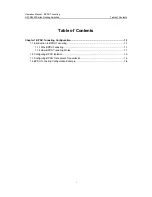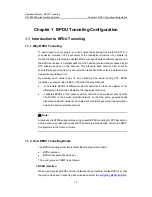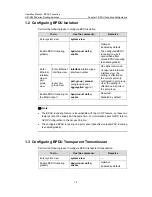
Operation Manual – VLAN
H3C S9500 Series Routing Switches
Chapter 3 Isolate-User VLAN Configuration
3-3
To do...
Use the command
Remarks
Access port
Refer to
Assigning an Access Port
to a VLAN
Add ports to the
secondary VLAN
and ensure that at
least one port has
the secondary
VLAN as its
default VLAN
Hybrid port
Refer to
Assigning a Hybrid Port to
a VLAN
Required
to choose
either
Quit to system view
quit
—
Configure the mapping between
the isolate-user-VLAN and
secondary VLAN
isolate-user-vlan
isolate-user-vlan-id secondary
secondary-vlan-id
[
to
secondary-vlan-id
]
Required
Note:
z
To create an isolate-user-VLAN, you need to disable the GVRP function first, and
vice versa.
z
After a mapping is configured, the system disallows adding ports to and removing
ports or VLANs from the mapped isolate-user-VLAN and secondary VLAN.
z
On the ports in a secondary VLAN, do not create MAC address entries with the
VLAN ID being that of an isolate-user-VLAN. For creation of MAC address entries,
refer to
MAC Address Management Commands
in the
System Volume
.
z
Do not create a VLAN interface for an isolate-user-VLAN.
3.3 Displaying and Maintaining Isolate-User-VLAN
To do...
Use the command...
Remarks
Display the mapping
between an
isolate-user-vlan and its
secondary VLAN(s)
display
isolate-user-vlan
[
isolate-user-vlan-id
]
Available in any view
3.4 Isolate-User-VLAN Configuration Example
I. Network requirements
z
Switch A is connected to Switch B and Switch C;
z
On Switch B, VLAN 5 is configured as an isolate-user-VLAN, which includes an
upstream port Ethernet 1/1/5 and two secondary VLANs VLAN 2 and VLAN 3.
VLAN 2 has Ethernet 1/1/2 and VLAN 3 has Ethernet 1/1/3.
















































